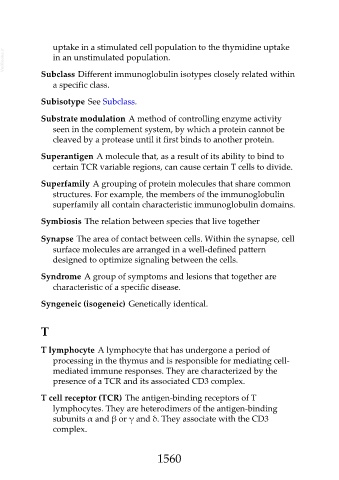Page 1560 - Veterinary Immunology, 10th Edition
P. 1560
uptake in a stimulated cell population to the thymidine uptake
VetBooks.ir in an unstimulated population.
Subclass Different immunoglobulin isotypes closely related within
a specific class.
Subisotype See Subclass.
Substrate modulation A method of controlling enzyme activity
seen in the complement system, by which a protein cannot be
cleaved by a protease until it first binds to another protein.
Superantigen A molecule that, as a result of its ability to bind to
certain TCR variable regions, can cause certain T cells to divide.
Superfamily A grouping of protein molecules that share common
structures. For example, the members of the immunoglobulin
superfamily all contain characteristic immunoglobulin domains.
Symbiosis The relation between species that live together
Synapse The area of contact between cells. Within the synapse, cell
surface molecules are arranged in a well-defined pattern
designed to optimize signaling between the cells.
Syndrome A group of symptoms and lesions that together are
characteristic of a specific disease.
Syngeneic (isogeneic) Genetically identical.
T
T lymphocyte A lymphocyte that has undergone a period of
processing in the thymus and is responsible for mediating cell-
mediated immune responses. They are characterized by the
presence of a TCR and its associated CD3 complex.
T cell receptor (TCR) The antigen-binding receptors of T
lymphocytes. They are heterodimers of the antigen-binding
subunits α and β or γ and δ. They associate with the CD3
complex.
1560

